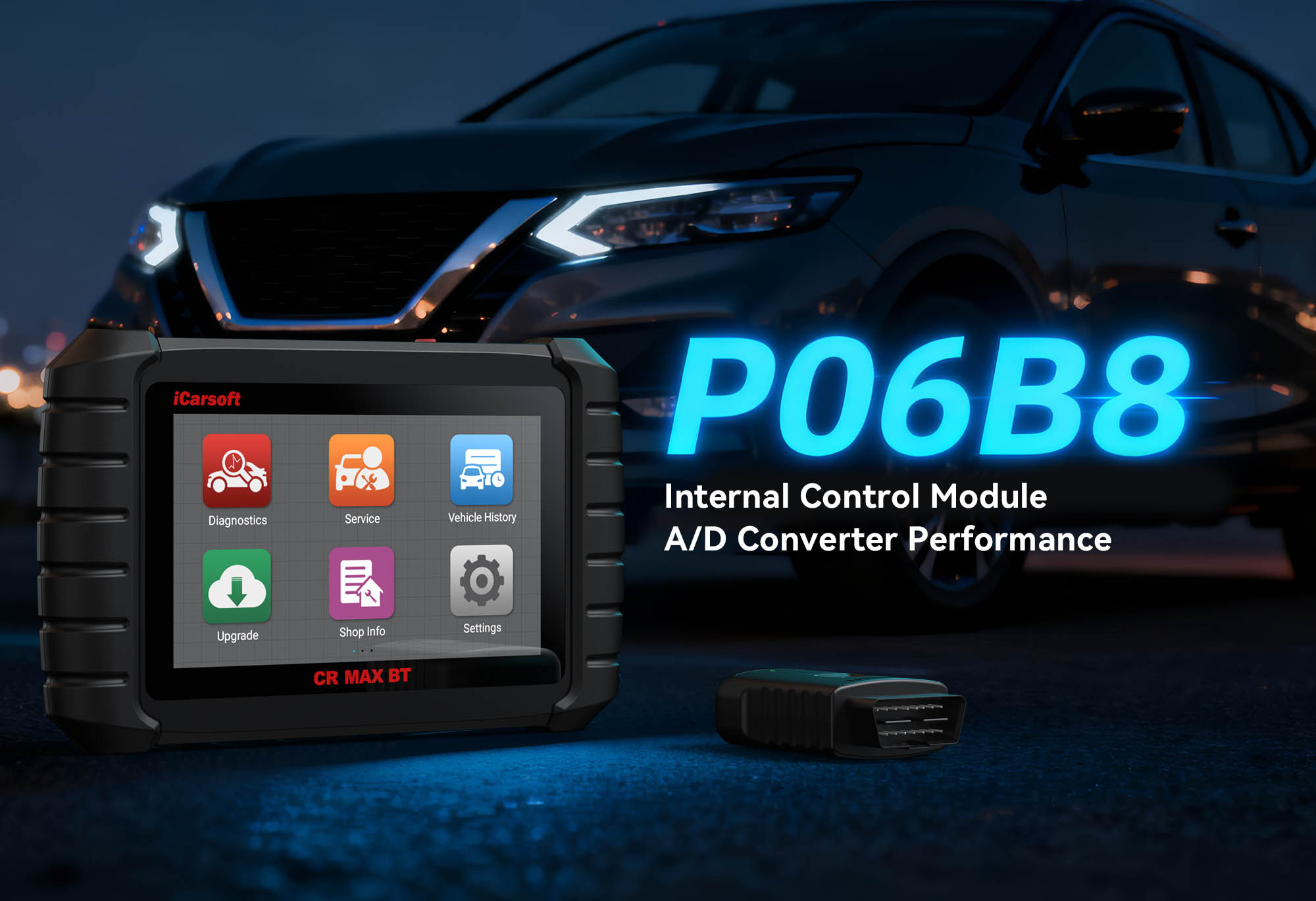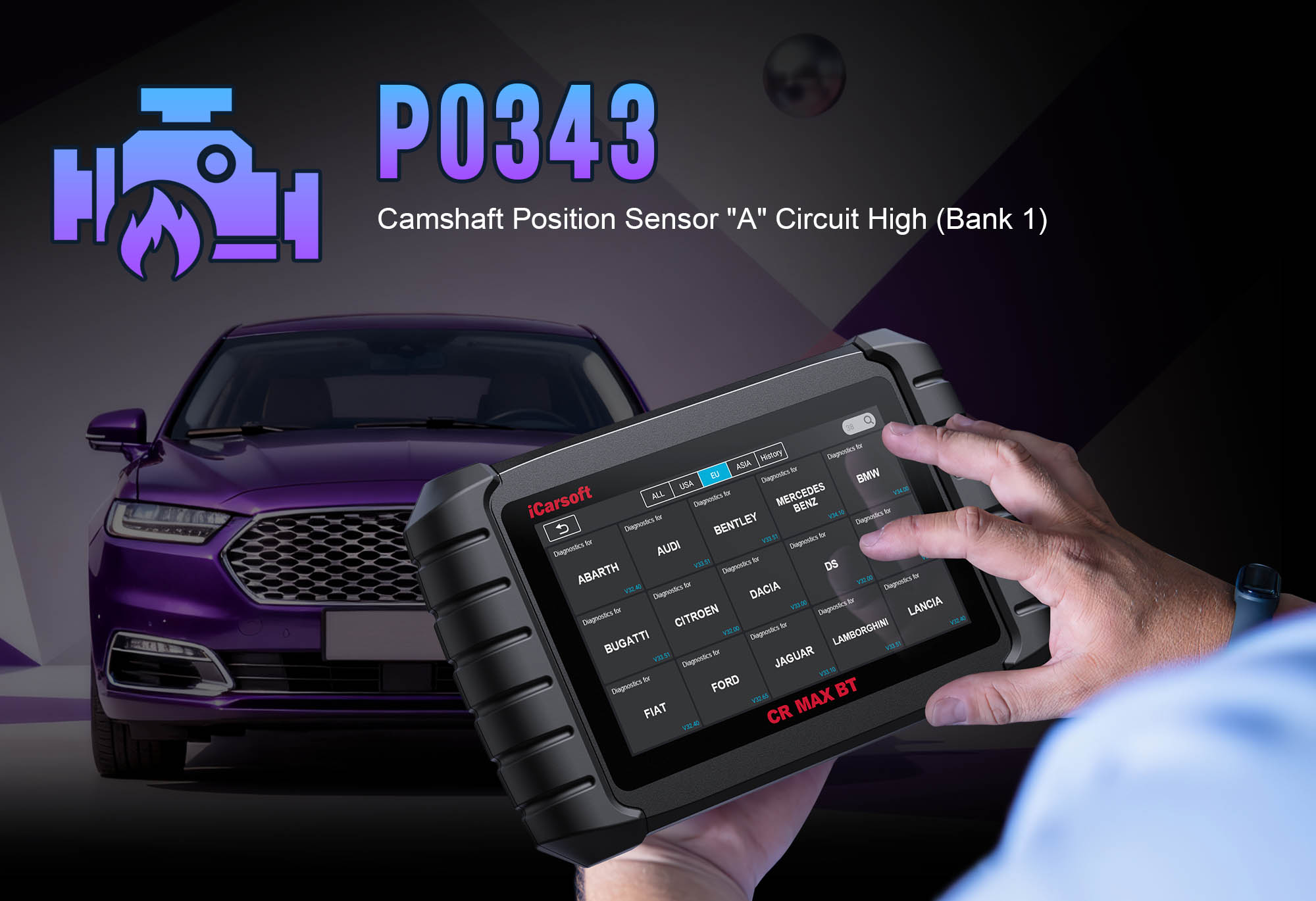Understand & Fix P0501: Vehicle Speed Sensor Range/Performance with iCarsoft CR Ultra P
If your vehicle’s check engine light illuminates, your speedometer acts erratically, or you notice issues with cruise control, a diagnostic scan will likely return P0501. This OBD-II code stands for "Vehicle Speed Sensor (VSS) Range/Performance"—a critical fault indicating the VSS is sending signals outside the normal operational range. The VSS monitors how fast your vehicle is moving, providing data to the Engine Control Module (ECM) for functions like fuel injection, transmission shifting, and cruise control. When its signals are inconsistent, inaccurate, or out of range, P0501 is triggered, disrupting key vehicle systems.
Basic scanners might only flag a "speed sensor error" but can’t compare live speed data against VSS signals, test sensor responsiveness, or validate wiring integrity—leaving you guessing between a faulty VSS, damaged wiring, or a failing instrument cluster. The iCarsoft CR Ultra P, with its OE-level speed sensor diagnostics, real-time data correlation, and circuit testing tools, solves this. Below, we break down P0501, its causes, symptoms, step-by-step resolution, and 8 FAQs to answer common troubleshooting questions.
What Is P0501?
P0501 focuses on the Vehicle Speed Sensor (VSS) and its signal output. The VSS is typically located on the transmission, transaxle, or wheel hub, using a magnetic or hall-effect sensor to generate an AC or digital signal proportional to vehicle speed (higher speed = more frequent signal pulses). The ECM expects this signal to fall within a specific range (e.g., 500–5,000 pulses per mile for most vehicles). When the signal drops below the minimum threshold, spikes above the maximum, or fluctuates unpredictably, the ECM triggers P0501. This disrupts speed-dependent systems like automatic transmissions (which rely on speed data for shifting) and anti-lock brakes (ABS).
Key Symptoms of P0501
-
Illuminated Check Engine Light: The primary warning sign, often paired with codes like P0500 (VSS circuit malfunction) or P0720 (output speed sensor fault).
-
Erratic Speedometer: The gauge fluctuates, shows incorrect speeds, or drops to zero even when moving.
-
Transmission Shifting Issues: Hard shifts, delayed shifts, or failure to shift into higher gears (common in automatic transmissions).
-
Cruise Control Failure: Cruise control may not engage, disengage unexpectedly, or maintain inconsistent speeds.
-
ABS Warning Light: Some vehicles trigger the ABS light, as the system relies on accurate speed data.
-
Reduced Fuel Efficiency: Incorrect speed signals disrupt the ECM’s fuel injection calculations, increasing consumption by 8–12%.
Common Causes of P0501
|
Cause
|
Description
|
|
Faulty Vehicle Speed Sensor (VSS)
|
A worn sensor with degraded internal components (e.g., damaged magnet or hall-effect chip) generates erratic signals.
|
|
Wiring/Circuit Issues
|
Frayed wires, corroded connectors, or loose terminals causing signal loss or interference.
|
|
Dirty or Damaged Sensor Gear/Ring
|
A contaminated or worn tone ring (on the transmission or wheel hub) disrupts the VSS’s ability to read speed.
|
|
Instrument Cluster Malfunction
|
A failing cluster may misinterpret VSS signals, though this rarely triggers P0501 directly.
|
|
ECM Software Glitch
|
Rarely, outdated ECM firmware misinterprets valid VSS signals as out of range.
|
Why iCarsoft CR Ultra P Excels at Diagnosing P0501
The CR Ultra P outperforms basic tools with features tailored to speed sensor and signal diagnostics:
Dual Data Correlation
Compares live VSS pulse signals against actual vehicle speed (GPS/wheel speed), highlighting discrepancies that trigger P0501.
Signal Waveform Analysis
Visualizes VSS output as a waveform, making it easy to spot irregularities (missing pulses, voltage spikes).
Bi-Directional Sensor Testing
Simulates VSS signals to verify ECM response—distinguishes sensor faults from ECM issues.
Circuit Integrity Checks
Tests for continuity, resistance, and voltage drops in VSS wiring with built-in multimeter functions.
Global Vehicle Coverage
Supports 200+ brands with transmission-mounted or wheel-speed-based VSS systems.
41 Hot Service Functions
Includes VSS calibration, transmission adaptive learning reset, and cluster synchronization—critical for post-repair validation.
Step-by-Step: Diagnose P0501 with iCarsoft CR Ultra P
-
Confirm P0501 & Gather Data
Plug the CR Ultra P into your vehicle’s OBD-II port, power on the tool, and select AutoVIN Identify to auto-detect make, model, and VSS type (transmission-mounted or wheel-based).
Navigate to Engine > Fault Codes > Read Codes to confirm P0501. Tap Code Details for model-specific insights (e.g., "Honda Civic: VSS Range/Performance; Signal: 300 Pulses/Mile, Expected: 500–3,000; Check VSS or Tone Ring").
-
Analyze Live VSS & Speed Data
Go to Engine > Live Data > Speed & Transmission and monitor three key metrics:
1. VSS Signal Frequency: Should increase steadily with speed. Fluctuations or out-of-range readings confirm P0501.
2. Actual vs. Reported Speed: CR Ultra P compares GPS/wheel speed with VSS-reported speed—mismatch = faulty sensor.
3. Transmission Shift Points: Delayed/hard shifts + erratic VSS = P0501 impact.
-
Test the Vehicle Speed Sensor (VSS)
1. Use Bi-Directional Control > Transmission > VSS Test: Simulate signals (e.g., 1,000 pulses/mile) and check speedometer/ECM response. No response = ECM/wiring; incorrect response = sensor fault.
2. Locate the VSS: Use the CR Ultra P’s Component Location tool (typically on transmission output shaft or wheel hub).
3. Inspect & Test: Check for oil contamination or loose connections. Use the CR Ultra P’s Resistance Test (should match OEM specs, e.g., 1,000–1,500 ohms—fluctuating resistance = faulty sensor).
-
Inspect Wiring, Tone Ring, & Related Components
1. Wiring Check: Use Continuity Test on VSS wiring for breaks. Look for damage near moving parts or heat sources.
2. Tone Ring Check: Inspect tone ring for cracks, missing teeth, or debris—clean with a soft brush if contaminated.
3. Instrument Cluster Check: Use the CR Ultra P’s Cluster Test (under Body Control) to verify speedometer response to simulated signals.
-
Repair & Clear the Code
- Replace the VSS if tests confirm it’s faulty (use OEM sensors for accurate pulse generation).
- Repair damaged wiring, clean corroded connectors, or replace a worn tone ring. Update ECM firmware if a software glitch is suspected.
- Use the CR Ultra P to Clear Codes and run a VSS Calibration Test. Test drive at varying speeds to confirm speedometer, shifts, and cruise control function normally.
FAQs: P0501 Troubleshooting
Can I drive with P0501?
Short trips are possible, but erratic transmission shifts and speedometer issues make long drives risky. Use the CR Ultra P to diagnose immediately.
How much does it cost to fix P0501?
A new VSS costs $30–$150, plus $80–$200 for labor (lower if the sensor is easily accessible on the transmission). The CR Ultra P saves on diagnostic fees ($100–$150).
Why does P0501 keep returning after clearing it?
The root cause wasn’t fixed. Common culprits: unrepaired wiring damage, a contaminated tone ring, or a failing ECM. Use the CR Ultra P’s History Log to track when the code reappears.
Is P0501 the same as a wheel speed sensor fault?
No—wheel speed sensors (WSS) monitor individual wheel speeds for ABS, while the VSS tracks overall vehicle speed. However, some vehicles use WSS data to calculate VSS signals; the CR Ultra P distinguishes between them.
How do I distinguish between a faulty VSS and wiring?
Compare live data: VSS signal erratic + stable voltage at connector = faulty VSS; VSS signal erratic + fluctuating voltage at connector = wiring issue.
Do I need to calibrate the VSS after replacement?
Yes—use the CR Ultra P’s VSS Calibration function to ensure the new sensor’s pulse rate matches the ECM’s expectations. This prevents future range errors.
Can cold weather cause P0501?
Yes—cold temperatures can cause wiring to contract (loosening connections) or moisture to corrode connectors, disrupting signals. Use the CR Ultra P’s Voltage Test to check for weather-related issues.
Will P0501 affect my vehicle’s safety?
Indirectly—erratic speedometer readings and transmission shifts increase accident risk. Fix P0501 with the CR Ultra P to restore safe operation.
Conclusion
P0501’s vehicle speed sensor range/performance fault disrupts critical systems like transmission shifting and cruise control, but the iCarsoft CR Ultra P simplifies diagnosis with dual data correlation, waveform analysis, and circuit testing. It ensures you fix the root cause—whether it’s a faulty sensor, damaged wiring, or a worn tone ring—instead of just clearing the code.
With a 10.1-inch HD touchscreen, 12600mAh long-life battery, and 3 years of free software updates, the CR Ultra P is a must-have for DIYers and mechanics. Resolve P0501, restore accurate speed readings, and ensure smooth transmission operation—all with one professional-grade diagnostic scanner.





